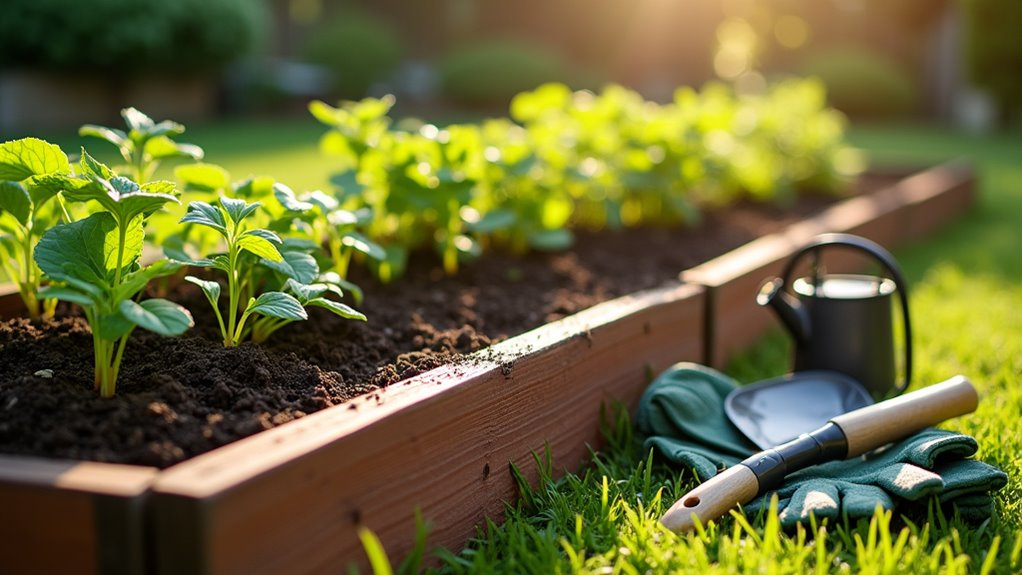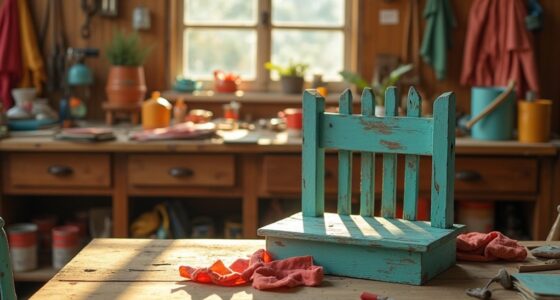To build a simple raised garden bed, gather six 2 x 6 x 8 cedar boards and four 4 x 4 cedar posts. Cut two boards in half for ends and secure them with wood screws. Choose a sunny spot and clear the area, then line the bottom with weed barrier cloth. Fill the bed with topsoil and compost for a rich blend. With these basics in place, you can explore more planting tips and creative designs for your garden.
Key Takeaways
- Gather materials: six 2 x 6 x 8 cedar boards, four 4 x 4 cedar posts, screws, and weed barrier cloth.
- Cut two cedar boards in half for the ends and secure to corner posts with screws.
- Line the bottom with weed barrier cloth or chicken wire for pest protection.
- Fill the completed bed with a nutrient-rich soil mix, starting with topsoil and compost.
- Choose a sunny location, clear the area, and ensure the site is level before building.
Materials Needed for Your Raised Garden Bed

When you decide to build a raised garden bed, having the right materials on hand makes the process smoother and more efficient.
Start with six 2 x 6 x 8 cedar boards for the sides and four 4 x 4 cedar posts for the corners. You’ll also need at least four 3/4 x 4 boards for interior support.
To secure everything, grab some 2-inch galvanized wood screws, which will guarantee your frame withstands the elements.
Consider adding a weed barrier cloth at the bottom to keep weeds and pests out while promoting healthy root growth.
Using untreated wood like cedar avoids chemical leaching, making it the perfect choice for your raised garden beds. Additionally, incorporating nutritional balance in your garden plan can enhance your food supply for emergencies.
With these materials, you’re ready to create your garden!
Tools Required for Construction
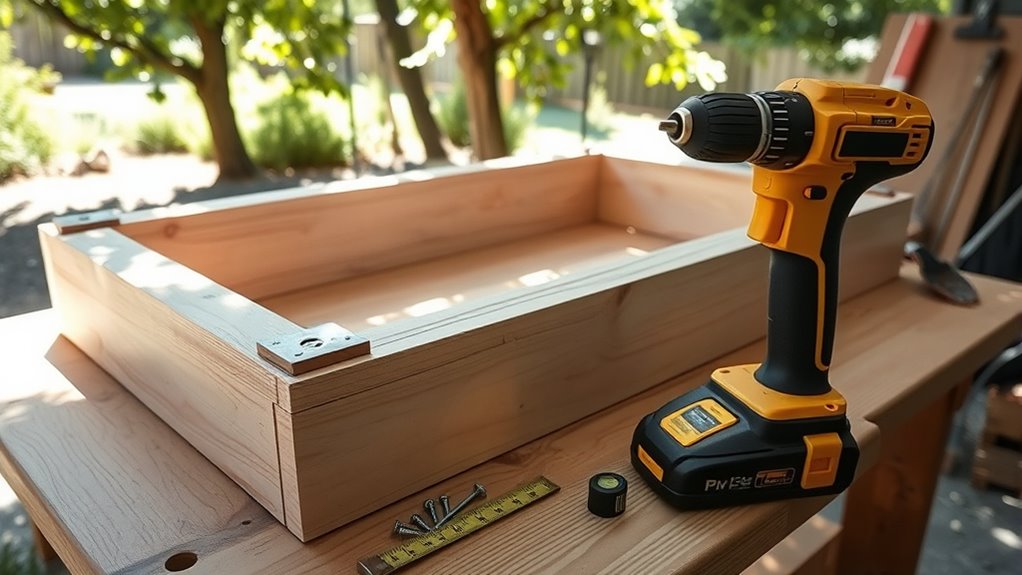
Building a raised garden bed requires a few essential tools to guarantee a smooth construction process.
First, you’ll need a saw to cut the wood to your desired lengths. A hand drill is vital for creating holes for screws, making sure everything stays securely in place. Additionally, smart shopping for quality materials can save you money and ensure durability. Consider using sustainable materials to enhance visual appeal and support eco-friendly practices. Heat pumps, for instance, can significantly lower energy bills and support your efforts to create a more sustainable garden environment.
Don’t forget your measuring tape; it helps you get accurate dimensions for your bed. A pencil is also necessary for marking the boards before cutting or drilling, which guarantees precision.
To secure screws and nuts tightly, a bolt tightener is very useful. Finally, if you’re planning to attach weed barrier cloth or chicken wire, a staple gun will help keep pests at bay. Additionally, ensuring proper lighting control can enhance the growth of your plants by optimizing photosynthesis.
With these tools, you’re well on your way to a successful build!
Step-by-Step Instructions for Building

With the right tools in hand, you’re ready to start constructing your raised garden bed.
Begin by cutting two 8-foot cedar boards in half, giving you four 4-foot long boards for the ends. Next, use 4×4 corner posts and secure the long boards to the posts with galvanized wood screws for stability. Monitoring watering needs is essential to ensure your plants thrive in the new environment, as proper watering is crucial for healthy plant growth. To achieve this, consider using the soak method for effective watering, which saturates the soil thoroughly.
Cut two 8-foot cedar boards in half for four 4-foot ends, then secure with 4×4 corner posts and galvanized wood screws.
Assemble the sides by attaching the shorter boards to the corners, ensuring they’re flush with the top of the posts for a clean finish. Line the bottom with a weed barrier cloth or chicken wire to keep weeds and pests out while allowing drainage. Incorporating a nutrient-rich soil mix will not only provide essential nutrients but also enhance the health of your plants.
Finally, fill your completed bed with a nutrient-rich soil mix, incorporating organic matter like compost to promote healthy plant growth.
Preparing the Site for Your Raised Bed
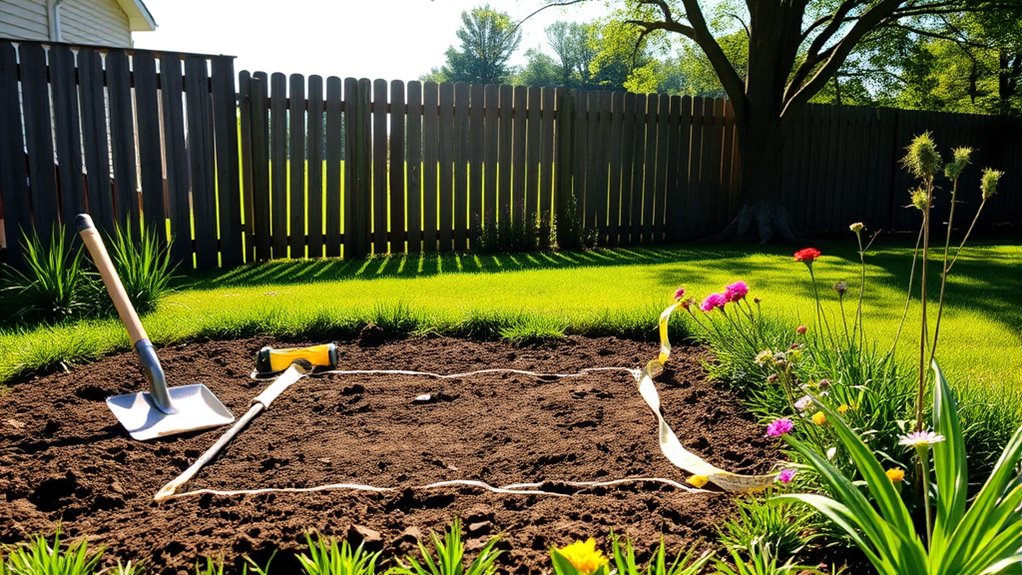
Before you start constructing your raised garden bed, it’s important to prepare the site properly to guarantee your plants thrive.
First, choose a location that receives at least 6-8 hours of sunlight daily. Next, clear the area of any grass, weeds, or debris to create a clean workspace.
Using a spading fork, loosen the soil beneath the planned bed area to enhance drainage and promote root growth. Make sure the site is level; this provides a stable foundation for your raised bed and prevents structural issues. Additionally, well-drained soil is crucial for healthy plant growth, as it helps prevent root rot and encourages better nutrient uptake. It’s advisable to research local building codes regarding any restrictions on garden bed construction in your area.
Finally, consider lining the bottom with weed barrier cloth or hardware cloth to deter weed growth and protect against digging animals. This preparation sets the stage for a flourishing garden. Additionally, incorporating sustainable materials in the construction of your raised bed can contribute to an eco-friendly gardening practice. By using curated lists of sustainable options, you can easily find the best materials for your project.
Filling Your Raised Bed With Soil
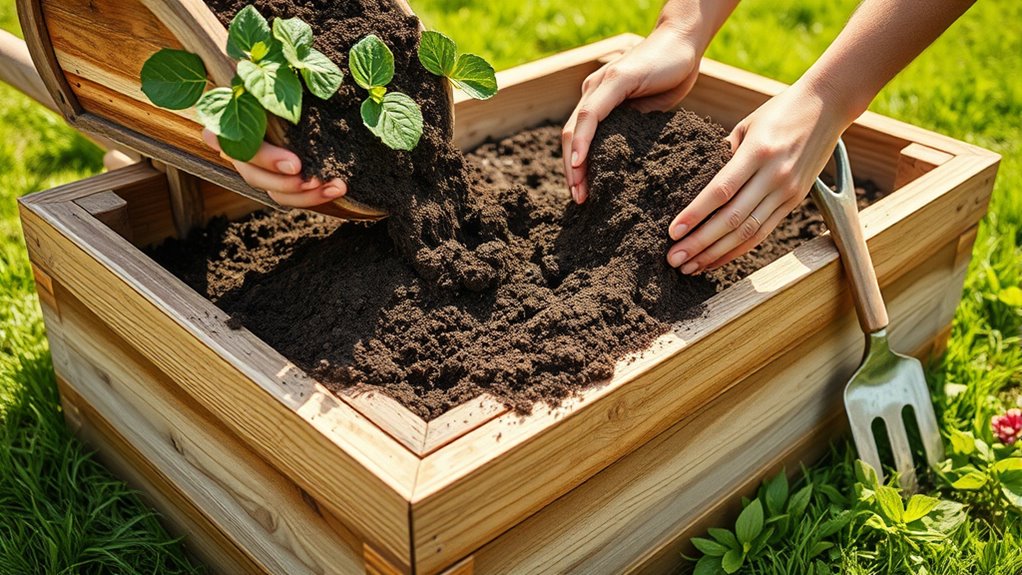
Once you’ve prepared your raised bed site, it’s time to fill it with the right soil mix to guarantee your plants thrive. Aim for a nutrient-rich soil and compost mix that promotes ideal growth.
Follow these steps:
- Topsoil: Start with high-quality topsoil to form the base.
- Compost Mix: Add a generous amount of compost mix to enrich the soil.
- Organic Materials: Incorporate organic materials like bat guano or worm castings for extra nutrients. Additionally, consider incorporating precious metals into your investment strategy, as they can serve as a hedge against inflation. You can also enhance soil quality by adding nutrient-rich compost which supports plant growth. Including low light office plants can help maintain a healthy environment for your garden by improving air quality.
- Water Thoroughly: After filling, water the soil thoroughly to guarantee proper drainage and even moisture.
Consider using a soil testing kit to check pH and nutrient levels, allowing you to amend the mix as needed for your raised bed garden’s specific plant requirements. Additionally, this process aligns with mindful consumption practices, emphasizing the importance of using quality materials to support a sustainable garden.
Planting Tips for Your Raised Garden Bed
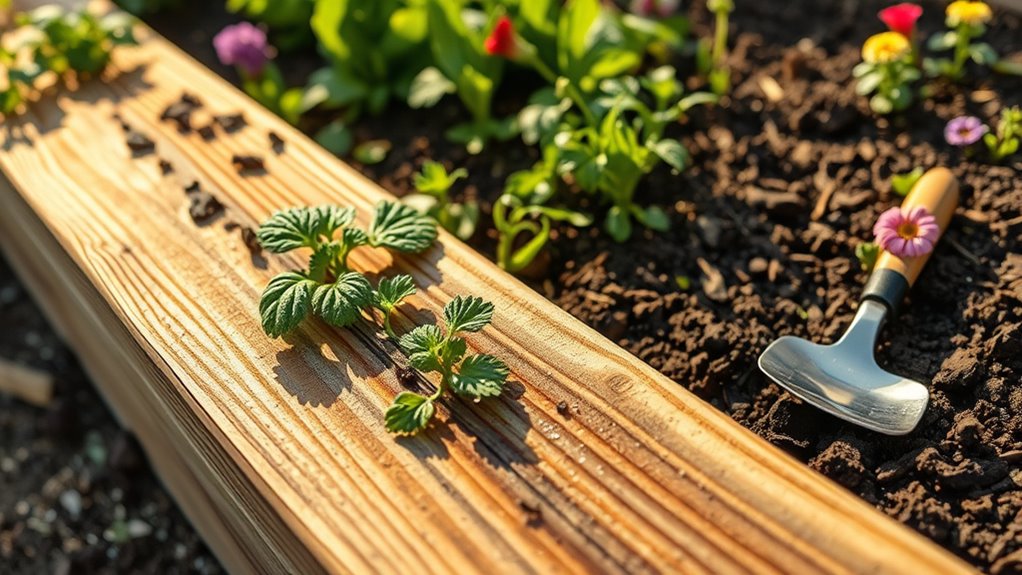
As you immerse yourself in planting your raised garden bed, remember that proper sunlight is essential for your plants’ success. Aim for at least 6-8 hours of sunlight daily. Use good, nutrient-rich soil by mixing topsoil, compost, and organic matter. To maximize your space, practice square foot gardening, dividing your raised beds into sections for various crops. Additionally, consider incorporating protein-rich options like beans into your planting plan for a balanced harvest. Including unique and wicked planters can also enhance your garden’s aesthetic and functionality. Adding cultural breakfast traditions to your meal plan can also inspire your gardening choices, as many plants can be incorporated into breakfast dishes.
| Crop | Planting Season | Rotation Tips |
|---|---|---|
| Tomatoes | Spring | Rotate after 1 year |
| Lettuce | Spring/Fall | Rotate after 1 year |
| Carrots | Spring | Rotate after 1 year |
| Peppers | Spring | Rotate after 1 year |
| Beans | Summer | Rotate after 1 year |
Water your plants at the base to minimize disease risk and boost growth! Additionally, be aware that cybersecurity measures are crucial even in gardening technology to protect your data and devices connected to your gardening systems.
Maintenance and Care for Your Garden Bed
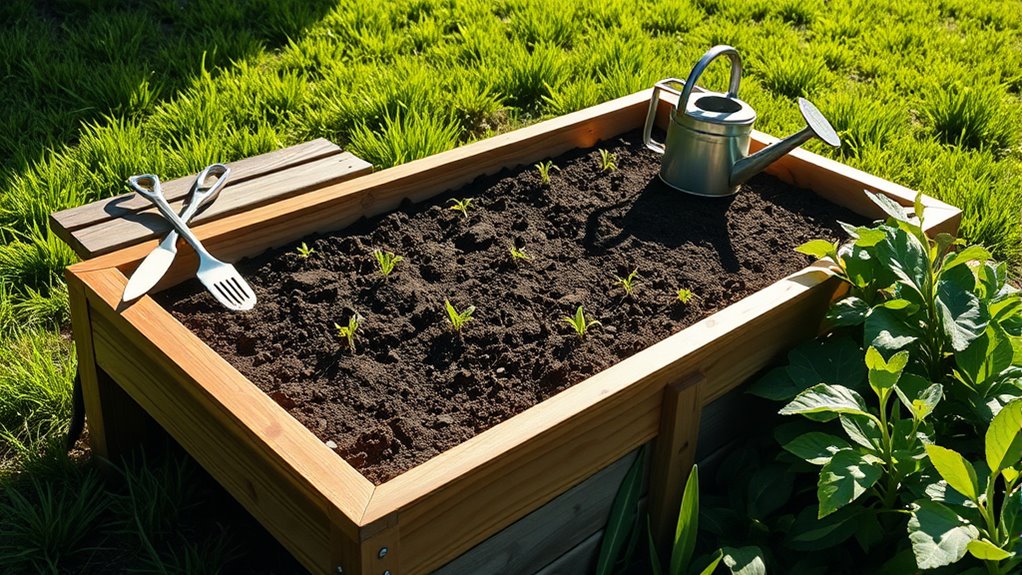
Maintaining your raised garden bed is essential for thriving plants.
You’ll need to establish a consistent watering schedule, keep your soil healthy with organic matter, and stay vigilant against pests and weeds. Additionally, following principles of sustainable gardening can help improve your garden’s ecosystem and promote healthier plant growth.
Watering Schedule and Techniques
To keep your raised garden bed thriving, establishing a consistent watering schedule is crucial. Aim for about 1-2 inches of water per week, adjusting for rainfall and temperature.
Here are some effective techniques:
- Water early in the morning to reduce evaporation and guarantee your plants get moisture throughout the day.
- Use a drip irrigation system or soaker hoses to deliver water directly to the roots, minimizing disease risks.
- Check soil moisture by sticking your finger an inch deep; if it’s dry, it’s time to water.
- Apply mulch like straw or wood chips around your plants to retain soil moisture and reduce how often you need to water.
Following these tips will keep your garden bed healthy and productive!
Soil Health Maintenance
Proper watering keeps your raised garden bed vibrant, but soil health maintenance takes it a step further. Regularly incorporate organic matter, like compost and worm castings, to boost soil fertility and improve structure. This practice promotes healthy plant growth.
To maintain soil moisture, water deeply and consistently, especially during dry spells, ensuring plants get adequate hydration without waterlogging. Use mulch, such as straw or grass clippings, around your plants to retain moisture, suppress weeds, and gradually enrich the soil as it decomposes.
Additionally, implement a crop rotation strategy to prevent nutrient depletion and test soil pH and nutrient levels annually. This way, you can make informed amendments and keep your garden bed thriving.
Pest and Weed Control
Effective pest and weed control is essential for the success of your raised garden bed. Here are some strategies to keep your garden thriving:
- Install hardware cloth at the bottom of your bed to deter pests like gophers and moles while ensuring drainage.
- Apply mulch regularly, using straw or grass clippings, to retain moisture and suppress weed growth.
- Practice hand-pulling weeds to minimize competition for nutrients and reduce soil disturbance.
- Utilize organic herbicides or vinegar solutions for targeted weed control in small patches.
Additionally, consider crop rotation each year to disrupt pest life cycles and prevent infestations.
These methods will help maintain a healthy garden ecosystem while keeping your plants flourishing.
Creative Ideas for Raised Garden Bed Designs
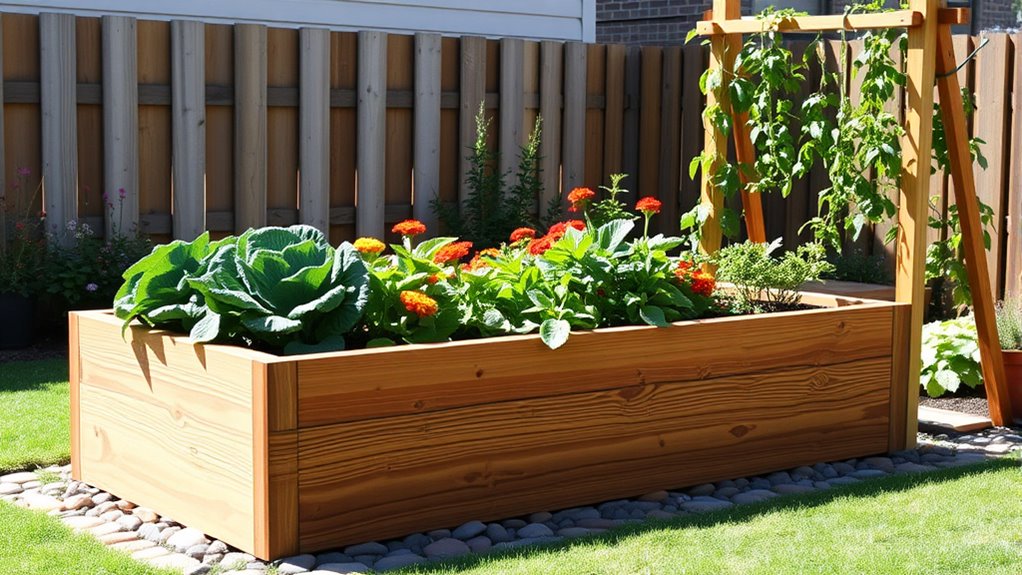
While traditional rectangular raised garden beds have their charm, you can elevate your gardening experience by exploring creative designs that enhance both functionality and aesthetics.
Consider incorporating a vertical garden within your raised bed, using trellises to grow climbing plants like beans and cucumbers. This maximizes space and adds visual interest.
Tiered raised beds create an eye-catching landscape, allowing for varying plant heights and improved sunlight exposure. You can also build a raised bed with integrated seating, providing a cozy spot to relax while tending to your plants.
Finally, utilize recycled materials like pallets or reclaimed wood for an eco-friendly touch, and experiment with shapes like circular or hexagonal beds to create a truly unique and creative gardening space.
Frequently Asked Questions
What Is the Cheapest Way to Build a Raised Garden Bed?
The cheapest way to build a raised garden bed is by using six cedar fence posts, which are rot-resistant and cost around $22 per bed.
You can further cut costs by repurposing lumber for the corners. For a clean look, cut the tops of the cedar picket fences and use 6-foot posts cut in half.
Avoid treated lumber to keep chemicals out of your soil, ensuring a safe and healthy environment for your plants.
What Do You Put in the Bottom of a Raised Garden Bed?
Imagine you’re setting up your first raised garden bed, excited to grow veggies. To guarantee success, you should line the bottom with a weed barrier cloth to stop pesky weeds.
Next, add a layer of gravel for drainage, preventing water from pooling. Consider mixing in some compost or straw to enrich the soil over time.
If you’re worried about digging animals, placing chicken wire underneath will provide added protection.
Happy gardening!
Is It Cheaper to Build or Buy a Raised Bed?
If you’re wondering whether it’s cheaper to build or buy a raised garden bed, DIY usually wins.
You can spend around $100 on materials like cedar, which is often less than pre-made kits that range from $150 to $300.
Plus, using repurposed lumber can cut costs even further.
Building your own lets you customize size and style, making it not only budget-friendly but also tailored to your gardening needs.
What Vegetables Should Not Be Grown in a Raised Bed?
When considering what vegetables not to grow in a raised bed, think about deep-rooted ones like asparagus and rhubarb, which need more soil depth.
Brassicas like cabbage can struggle with spacing issues, while potatoes might suffer from rot if overwatered.
Perennials such as artichokes can outgrow the space, and root vegetables like carrots need deeper soil for proper development.
Choosing the right plants will help you maximize your garden’s potential.
Conclusion
Building your own raised garden bed is more than just a weekend project; it’s an investment in your future harvest. With the right materials and some simple steps, you can create a thriving space for your plants. Remember, nurturing your garden bed doesn’t stop at planting—consistent care is key. So, roll up your sleeves, dig in, and watch your garden flourish. After all, a little effort today can yield bountiful rewards tomorrow!
